Dynamic Control of Integrated Wind Farm Battery Energy Storage Systems for Grid Connection
Abstract
1. Introduction
- Identify a suitable dynamic control system model and choose battery type for a South African Grid connected Wind Farm BESS,
- Modelling of an integrated wind farm battery energy storage model for grid connection, and
- Conduct a simulation to investigate the effects and impacts of integrated wind farm battery energy storage for grid connection.
2. The Proposed Method
2.1. System Discription
2.2. Control System Modelling
- Optimization in real time and physical limitations of device overall behavior with MPC,
- Updating the reference signal according to machine states and forecast price and wind power estimates, and
- Increased management of the electricity market with the BESS wind farms while retaining the power signal ramp inside predefined barriers.
2.3. BESS Model
2.3.1. Generic BESS Model
- Mitigate fluctuations of wind farm variable output, and
- Maintain power stability for grid connection?
2.3.2. BESS Model for Sodium–Sulfur (NAS) Battery
- Long duration
- High Power
- Long life expectancy
2.4. Reference Generator Model
- When the wind power is low, we supply the grid with electricity (with less storage and more supplies) wherever possible.
- Whenever the wind is high, we save as much energy as possible into the battery (it means more storage and less grid delivery).
2.5. Wind Power Prediction Model
2.6. Dynamic Controller Design
3. Case Study
3.1. Data Collection
3.2. Battery Selection Type
3.3. The Study
3.4. Network Simulation
3.5. Study Cases
4. Results and Discussion
4.1. Study Case 1: Load Flow and Fault Analysis
4.1.1. Load Flow
4.1.2. Fault Analysis
4.1.3. Discussion
- Frequency controller (Frequency Control)
- Active/reactive power controller (PQ-Control)
- Charging controller (Charge Control)
4.2. Study Case 2: Load Change
4.2.1. Load Step Down (−30 MW)
4.2.2. Load Step Down (+30 MW)
4.2.3. Discussion
4.3. Study Case 3: Wind Farm Outage
4.3.1. Wind Farm 20% Outage Load Step Down (−30 MW)
4.3.2. Wind Farm 20% Outage Load Step Down (+30 MW)
4.3.3. Discussion
5. Conclusions
Author Contributions
Funding
Institutional Review Board Statement
Informed Consent Statement
Data Availability Statement
Conflicts of Interest
Abbreviations
| PV | Photovoltaics |
| IPP | Independent Power Producers |
| RESs | Renewable Energy Sources |
| DFIG | Double Fed Induction Generator |
| BESSs | Battery Energy Storage Systems |
| HAWT | Horizontal Axis Wind Turbine |
| VAWT | Vertical Axis Wind Turbine |
| kW | kilo Watt |
| WECS | Wind Energy Conversion System |
| EESS | Electrical Energy Storage Systems |
| AW | Action Windpower |
| WES | Wind Energy System |
| WTs | Wind Turbines |
| DigSILENT | Digital Simulator for Electrical Network |
| DoE | Department of Energy |
References
- Eskom. Application for a Generator Connection to the Eskom Network. 2013. Available online: http://www.eskom.co.za/Whatweredoing/Documents/IPP_GridApplicationForm_Rev8_5Nov2013.pdf (accessed on 19 April 2018).
- International Energy Agency. World Energy Outlook 2016 Part B: Special Focus on Renewable Energy. Available online: https://www.iea.org/media/publications/weo/WEO2016SpecialFocusonRenewableEnergy.pdf (accessed on 19 April 2018).
- Department of Energy. Integrated Resource Plan for 2010–2030. 2011. Available online: http://www.energy.gov.za/IRP/irpfiles/IRP2010_2030_Final_Report_20110325.pdf (accessed on 19 April 2018).
- Eskom. Grid Connection Code for Renewable Power Plants (RPPs) Connected to the Electricity System or the Distribution System in South Africa. 2014. Available online: https://www.sseg.org.za/wp-content/uploads/2019/03/South-African-Grid-Code-Requirements-for-Renewable-Power-Plants-Version-2-8.pdf (accessed on 18 February 2021).
- Kelly, J.J.; Leahy, P.G. Sizing Battery Energy Storage Systems: Using Multi-Objective Optimization to Overcome the Investment Scale Problem of Annual Worth. IEEE Trans. Sustain. Energy 2019, 11, 2305–2314. [Google Scholar] [CrossRef]
- Sheng, D.; Dai, H.; Chen, M.; Chi, Y. Discussion of wind farm integration in China. In Proceedings of the 2005 IEEE/PES Transmission & Distribution Conference & Exposition: Asia and Pacific, Dalian, China, 18 August 2005. [Google Scholar]
- Abhinav, R.; Pindoriya, N.M. Grid integration of wind turbine and battery energy storage system: Review and key challenges. In Proceedings of the 2016 IEEE 6th International Conference on Power Systems (ICPS), New Delhi, India, 4–6 March 2016; pp. 1–6. [Google Scholar]
- Ohki, Y. World’s Largest-Class Battery Energy Storage System. IEEE Electr. Insul. Mag. 2016, 32, 64–66. [Google Scholar] [CrossRef]
- Saber, H.; Heidarabadi, H.; Moeini-Aghtaie, M.; Farzin, H.; Karimi, M.R. Expansion Planning Studies of Independent-Locally Operated Battery Energy Storage Systems (BESSs): A CVaR-Based Study. IEEE Trans. Sustain. Energy 2019, 11, 2109–2118. [Google Scholar] [CrossRef]
- World Energy Council. Five Steps to Energy Storage. Innovation Insights Brief. 2020, p. 62. Available online: www.worldenergy.org (accessed on 18 February 2021).
- DIgSILENT GmbH. DIgSILENT PowerFactory Application Example Battery Energy Storing Systems. 2010, pp. 1–28. Available online: https://www.digsilent.de/en/faq-reader-powerfactory/do-you-have-an-application-example-for-a-battery-energy-storage-system-bess.html (accessed on 18 February 2021).
- Zakeri, B.; Syri, S. Electrical energy storage systems: A comparative life cycle cost analysis. Renew. Sustain. Energy Rev. 2015, 42, 569–596. [Google Scholar] [CrossRef]
- Fathima, A.H.; Palanisamy, K. Battery energy storage applications in wind integrated systems—A review. In Proceedings of the 2014 International Conference on Smart Electric Grid (ISEG), Guntur, India, 19–30 September 2014; pp. 1–8. [Google Scholar]
- Zarei Fard, M.T. Modelling and Control of Wind Farms Integrated with Battery Energy Storage Systems. Ph.D. Thesis, The University of New South Wales, Sydney, Australia, August 2017. [Google Scholar]
- Hansen, A.D.; Rensen, P.S.; Blaabjerg, F.; Becho, J. Dynamic Modelling of Wind Farm Grid Interaction. Wind. Eng. 2002, 26, 191–210. [Google Scholar] [CrossRef]
- Shi, R.; Li, S.; Zhang, P.; Lee, K.Y. Integration of renewable energy sources and electric vehicles in V2G network with adjustable robust optimization. Renew. Energy 2020, 153, 1067–1080. [Google Scholar] [CrossRef]
- Hosseini, S.M.; Carli, R.; Dotoli, M. A Residential Demand-Side Management Strategy under Nonlinear Pricing Based on Robust Model Predictive Control. In Proceedings of the 2019 IEEE International Conference on Systems, Man and Cybernetics (SMC), Bari, Italy, 6–9 October 2019; pp. 3243–3248. [Google Scholar]
- Banzo, M.; Ramos, A. Stochastic Optimization Model for Electric Power System Planning of Offshore Wind Farms. IEEE Trans. Power Syst. 2010, 26, 1338–1348. [Google Scholar] [CrossRef]
- Sperstad, I.B.; Korpås, M. Energy Storage Scheduling in Distribution Systems Considering Wind and Photovoltaic Generation Uncertainties. Energies 2019, 12, 1231. [Google Scholar] [CrossRef]
- Safdarian, A.; Fotuhi-Firuzabad, M.; Lehtonen, M. A Stochastic Framework for Short-Term Operation of a Distribution Company. IEEE Trans. Power Syst. 2013, 28, 4712–4721. [Google Scholar] [CrossRef]
- Mavromatidis, G.; Orehounig, K.; Carmeliet, J. Design of distributed energy systems under uncertainty: A two-stage stochastic programming approach. Appl. Energy 2018, 222, 932–950. [Google Scholar] [CrossRef]
- Ghasemi, A.; Banejad, M.; Rahimiyan, M. Integrated energy scheduling under uncertainty in a micro energy grid. IET Gener. Transm. Distrib. 2018, 12, 2887–2896. [Google Scholar] [CrossRef]
- Luta, D.N. Modelling of Hybrid Solar Wind Intergrated Generation Systems in an Electrical Distribution Network. Master’s Thesis, The Cape Peninsula University of Technology, Cape Town, South Africa, September 2014. [Google Scholar]
- Liu, Y.; Liu, S.L.; Wen, J.Y. Investigation on Control Strategies to Smooth out Wind Farm Output Fluctuations Using Energy Storage System. Appl. Mech. Mater. 2014, 521, 117–123. [Google Scholar] [CrossRef]
- Wang, W.; Ma, R.; Xu, H.; Wang, H.; Cao, K.; Chen, L.; Ren, Z. Method of energy storage system sizing for wind power generation Integration. In Proceedings of the 2016 IEEE PES Asia-Pacific Power and Energy Engineering Conference (APPEEC), Xian, China, 25–28 October 2016; pp. 1200–1203. [Google Scholar]
- Branco, H.; Castro, R.; Lopes, A.S. Battery energy storage systems as a way to integrate renewable energy in small isolated power systems. Energy Sustain. Dev. 2018, 43, 90–99. [Google Scholar] [CrossRef]
- Schaffarczyk, A. Understanding Wind Power Technology; John Wiley & Sons, Inc.: Hoboken, NJ, USA, 2014. [Google Scholar]
- Kulakowski, B.T.; Gardner, J.F.; Shearer, J.L. Dynamic Modelling and Control of Engineering Systems; Cambridge University Press: Cambridge, UK, 2013; Volume 53. [Google Scholar]
- Sperstad, I.B.; Helseth, A.; Korpas, M. Valuation of stored energy in dynamic optimal power flow of distribution systems with energy storage. In Proceedings of the 2016 International Conference on Probabilistic Methods Applied to Power Systems (PMAPS), Beijing, China, 16–20 October 2016; pp. 1–8. [Google Scholar]
- Yang, D.; Wen, J.; Chan, K.W.; Cai, G. Dispatching of Wind/Battery Energy Storage Hybrid Systems Using Inner Point Method-Based Model Predictive Control. Energies 2016, 9, 629. [Google Scholar] [CrossRef]
- Liu, W.; Liu, Y. Hierarchical model predictive control of wind farm with energy storage system for frequency regulation during black-start. Int. J. Electr. Power Energy Syst. 2020, 119, 105893. [Google Scholar] [CrossRef]
- Hu, J.; Shan, Y.; Guerrero, J.M.; Ioinovici, A.; Chan, K.W.; Rodriguez, J. Model predictive control of microgrids—An overview. Renew. Sustain. Energy Rev. 2021, 136, 110422. [Google Scholar] [CrossRef]
- Zhang, F.; Fu, A.; Ding, L.; Wu, Q. MPC based control strategy for battery energy storage station in a grid with high photovoltaic power penetration. Int. J. Electr. Power Energy Syst. 2020, 115, 105448. [Google Scholar] [CrossRef]
- Jadidi, S.; Badihi, H.; Zhang, Y. Passive Fault-Tolerant Control Strategies for Power Converter in a Hybrid Microgrid. Energies 2020, 13, 5625. [Google Scholar] [CrossRef]
- Rodríguez del Nozal, Á.; Gutiérrez Reina, D.; Alvarado-Barrios, L.; Tapia, A.; Escaño, J.M. A MPC Strategy for the Optimal Management of Microgrids Based on Evolutionary Optimization. Electronics 2019, 8, 1371. [Google Scholar] [CrossRef]
- Sun, Y.; Zhao, Z.; Yang, M.; Jia, D.; Pei, W.; Xu, B. Research overview of energy storage in renewable energy power fluctuation mitigation. CSEE J. Power Energy Syst. 2019, 6, 160–173. [Google Scholar] [CrossRef]
- Hosseini, S.M.; Carli, R.; Dotoli, M. Robust Optimal Energy Management of a Residential Microgrid under Uncertainties on Demand and Renewable Power Generation. IEEE Trans. Autom. Sci. Eng. 2020, 1–20. [Google Scholar] [CrossRef]
- Shepherd, W.; Zhang, L. Electricity Generation Using Wind Power; World Scientific: Singapore, 2011. [Google Scholar]
- Gustavo, M.; Gimenez, J. Technical and Regulatory Exigencies for Grid Connection of Wind Generation. In Wind Farm—Technical Regulations, Potential Estimation and Siting Assessment; IntechOpen: London, UK, 2011. [Google Scholar]
- European Wind Energy Association, “Contact,” 2021. Available online: https://www.wind-energy-the-facts.org/contact.html (accessed on 14 February 2021).
- Yun, P.; Ren, Y.; Xue, Y. Energy-Storage Optimization Strategy for Reducing Wind Power Fluctuation via Markov Prediction and PSO Method. Energies 2018, 11, 3393. [Google Scholar] [CrossRef]
- Palm, W.J. Basic Control Systems Design. Eshbach’s Handbook of Engineering Fundamentals; Wiley Online Library: Hoboken, NJ, USA, 2009; pp. 760–801. [Google Scholar] [CrossRef]
- Veldhuis, S.; Dosbaeva, G.; Yamamoto, K. Tribological compatibility and improvement of machining productivity and surface integrity. Tribol. Int. 2009, 42, 1004–1010. [Google Scholar] [CrossRef]
- NGK Insulators LTD. Case Studies 3,700MWh/530MW Effectively Stored and Utilized in 200 Locations; NGK Insulators LTD: Cape Town, South Africa, 2016. [Google Scholar]
- Tamyürek, B.; Nichols, D.K. Performance Analysis of Sodium Sulfur Battery in Energy Storage and Power Qaulity Applications. Eskişehir Osman. Univ. 2004, 17, 99–115. [Google Scholar]
- Hussien, Z.F.; Cheung, L.W.; Siam, M.F.M.; Ismail, A.B. Modeling of Sodium Sulfur Battery for Power System Applications. 2007. Available online: http://fke.utm.my/elektrika (accessed on 31 January 2021).
- Kamibayashi, M.; Furuta, K. High Charge and Discharge Cycle Durability of the Sodium Sulfur (NAS) Battery. Available online: https://www.sandia.gov/ess-ssl/EESAT/2002_papers/00021.pdf (accessed on 18 February 2021).
- NGK Insulators. About NAS Batteries, Products, NGK Insulators, LTD. 2020. Available online: https://www.ngk-insulators.com/en/product/nas/about/index.html (accessed on 1 September 2020).
- Khalid, M.; Savkin, A.V. Closure to discussion on “A method for short-term wind power prediction with multiple observation points”. IEEE Trans. Power Syst. 2013, 28, 1898–1899. [Google Scholar] [CrossRef]
- Khalid, M.; Savkin, A.V. A Method for Short-Term Wind Power Prediction with Multiple Observation Points. IEEE Trans. Power Syst. 2012, 27, 579–586. [Google Scholar] [CrossRef]
- Sørensen, P. Simulation of Interaction between Wind Farm and Power System; Risø DTU National Laboratory for Sustainable Energy: Roskilde, Denmark, December 2001. [Google Scholar]
- Kroes, J. Gouda Wind Facility NERSA Public Hearings Cape Town; NERSA: Pretoria, South Africa, 2012. [Google Scholar]
- Acciona Windpower. Unpublished Service and User Manaul AW 300; Acciona Windpower: Hamburg, Germany, 2011. [Google Scholar]
- Acciona Windpower. Unpublished Consolidated Generation Data; Acciona Windpower: Hamburg, Germany, 2019. [Google Scholar]
- Tong, W. Fundamentals of Wind Energy; WIT Press: Southamption, UK, 2010; Volume 30. [Google Scholar]
- Ma, Y.; Wu, L. A stimulation study of the dynamic power control method for VSCF doubly-fed induction wind turbine based on Labview. In Proceedings of the 2009 World Non-Grid-Connected Wind Power and Energy Conference, Nanjing, China, 24–26 September 2009; pp. 1–4. [Google Scholar]
- Paul, S.; Nath, A.P.; Rather, Z.H. A Multi-Objective Planning Framework for Coordinated Generation from Offshore Wind Farm and Battery Energy Storage System. IEEE Trans. Sustain. Energy 2019, 11, 2087–2097. [Google Scholar] [CrossRef]
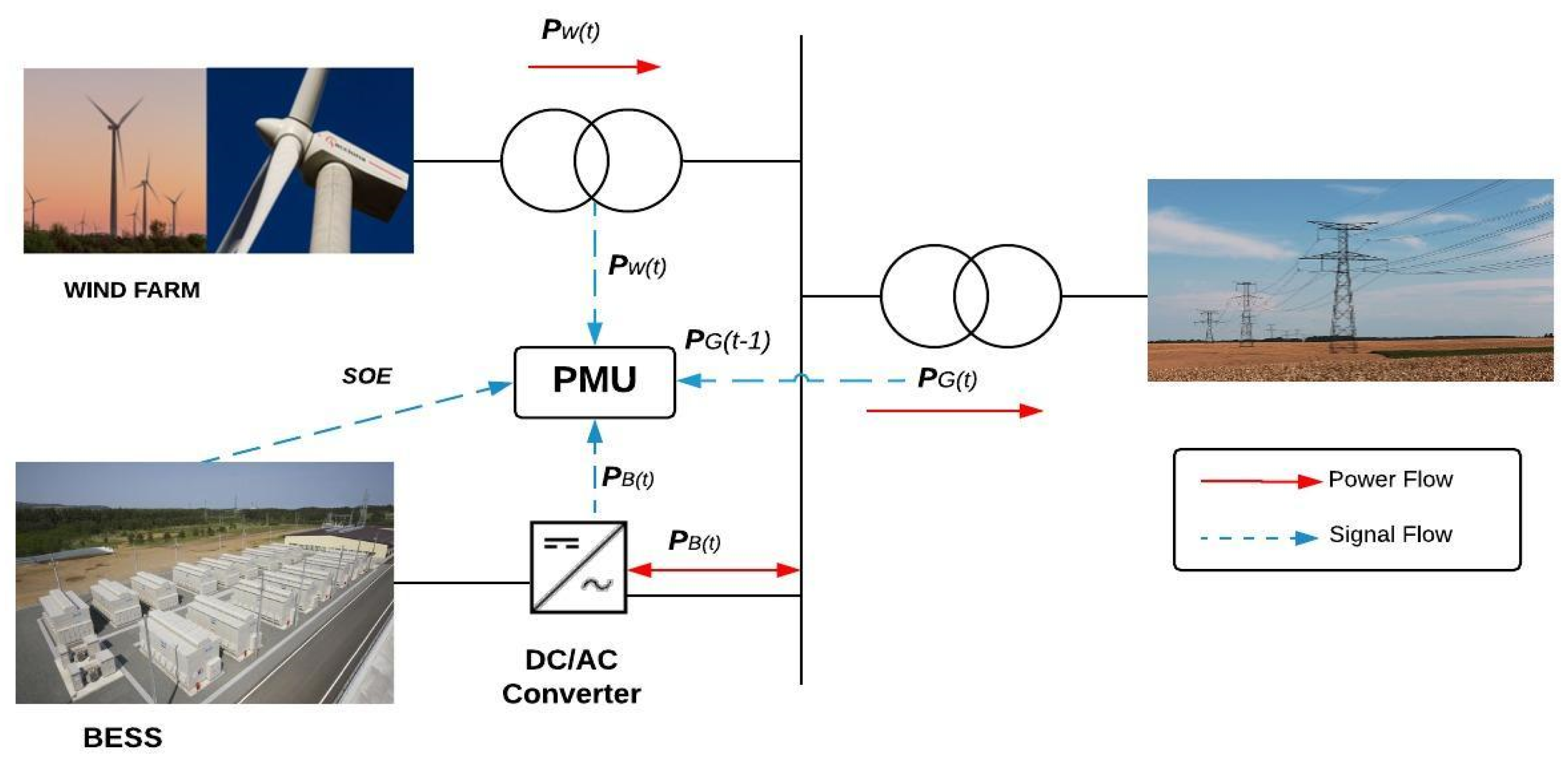
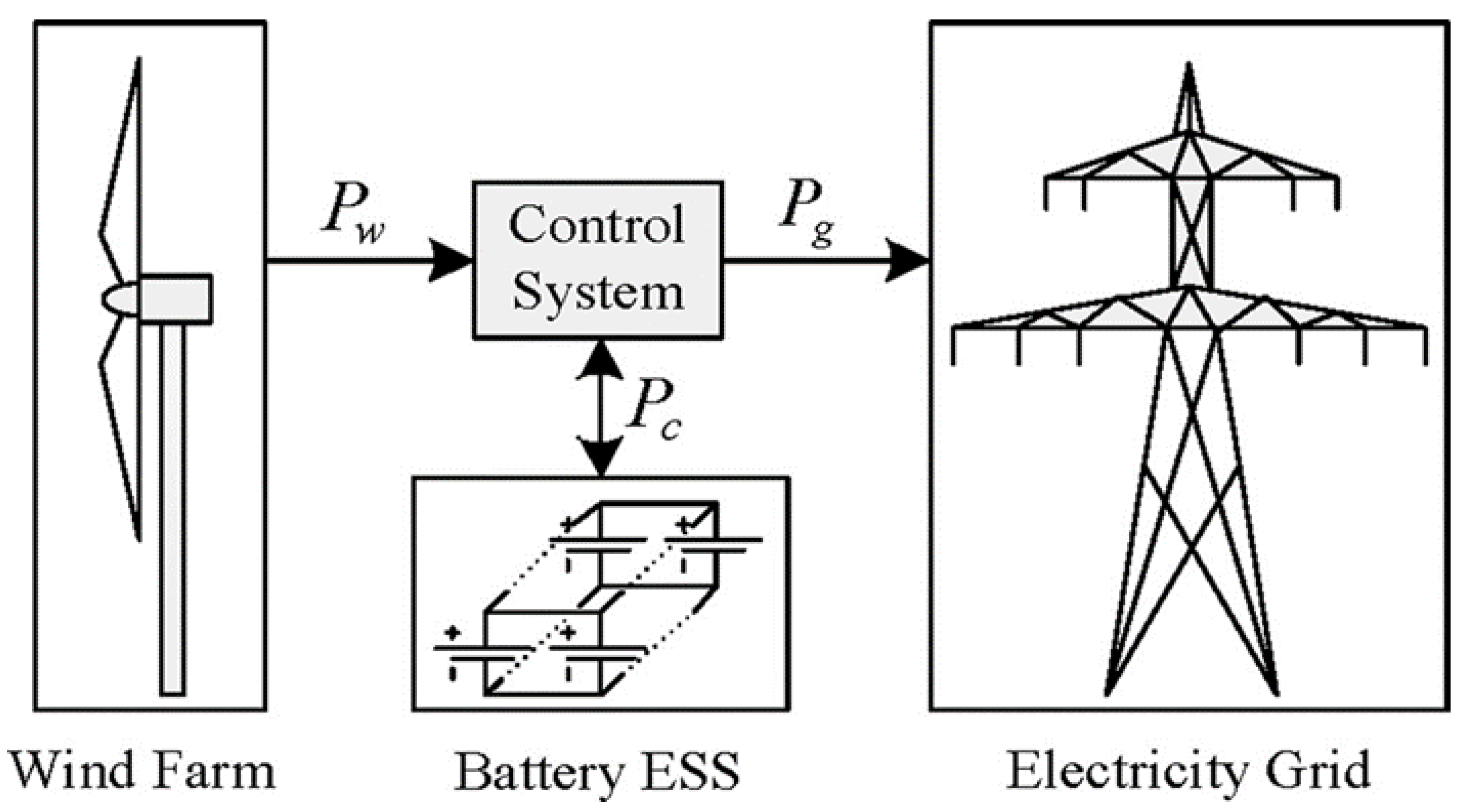
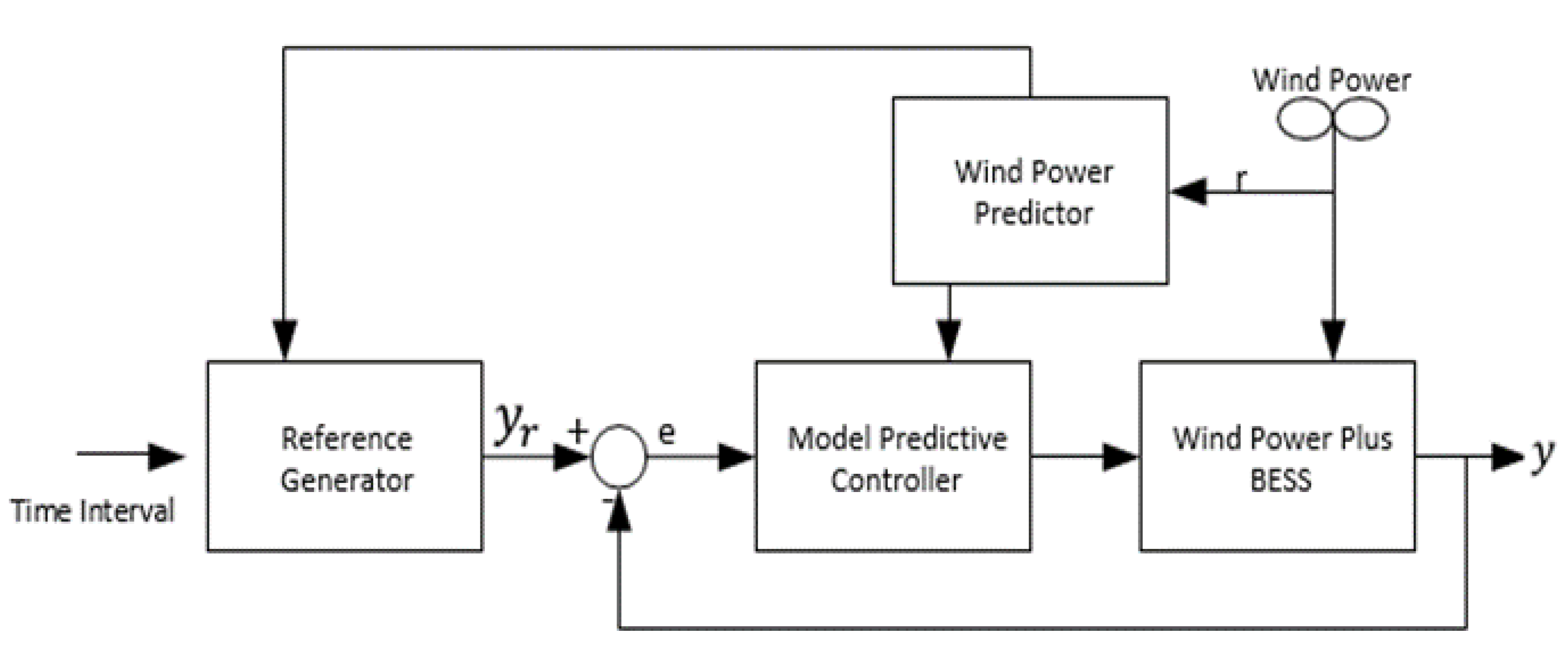


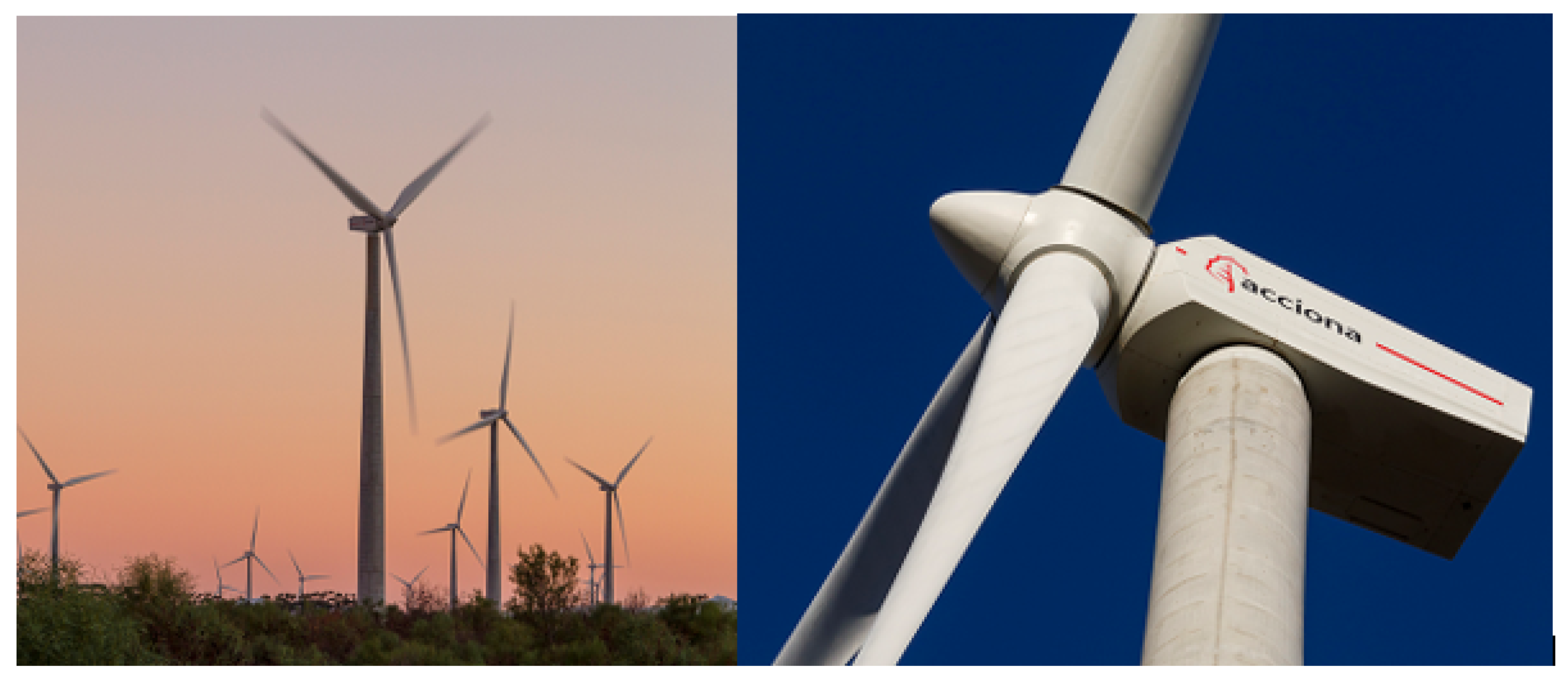
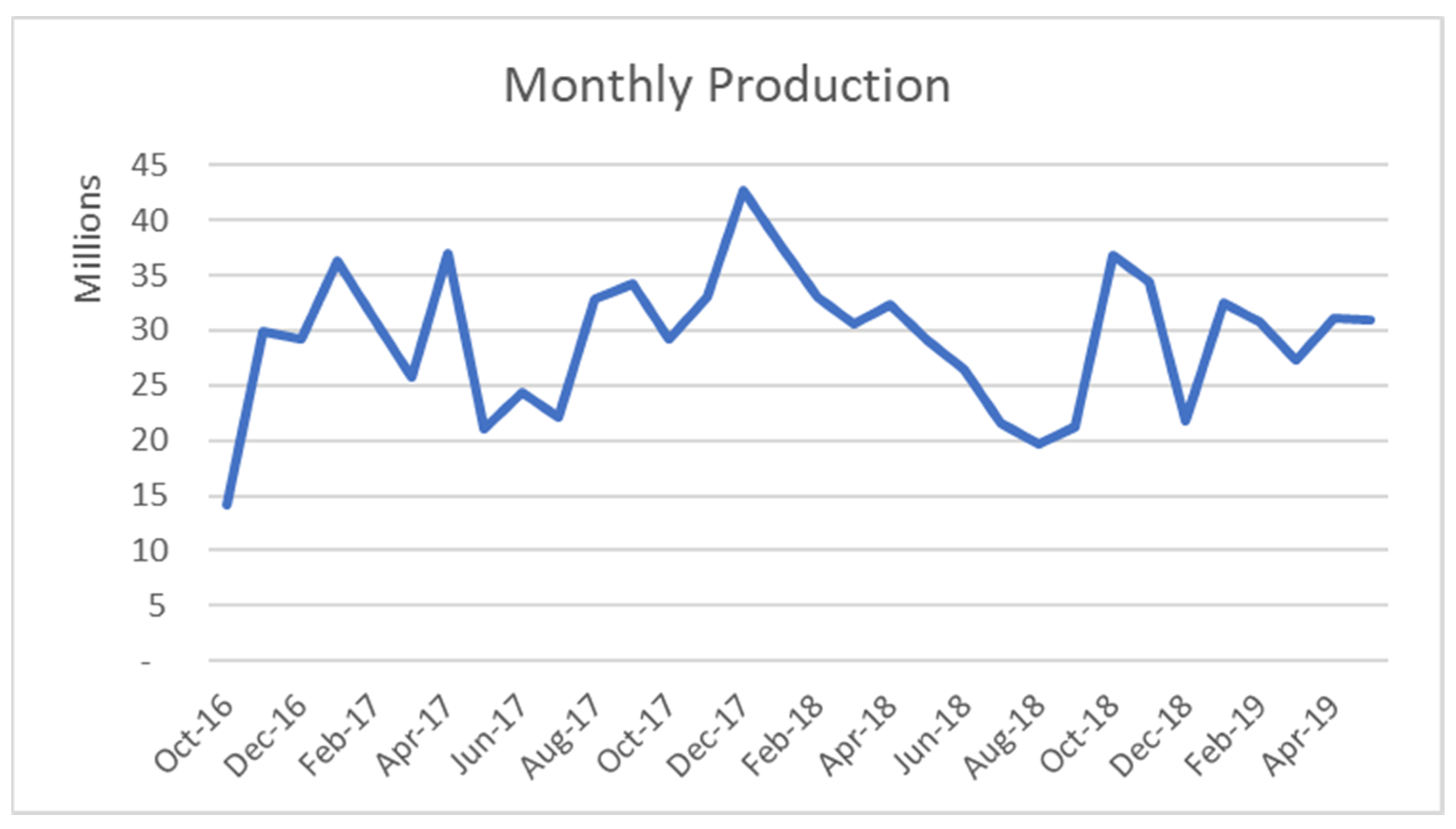

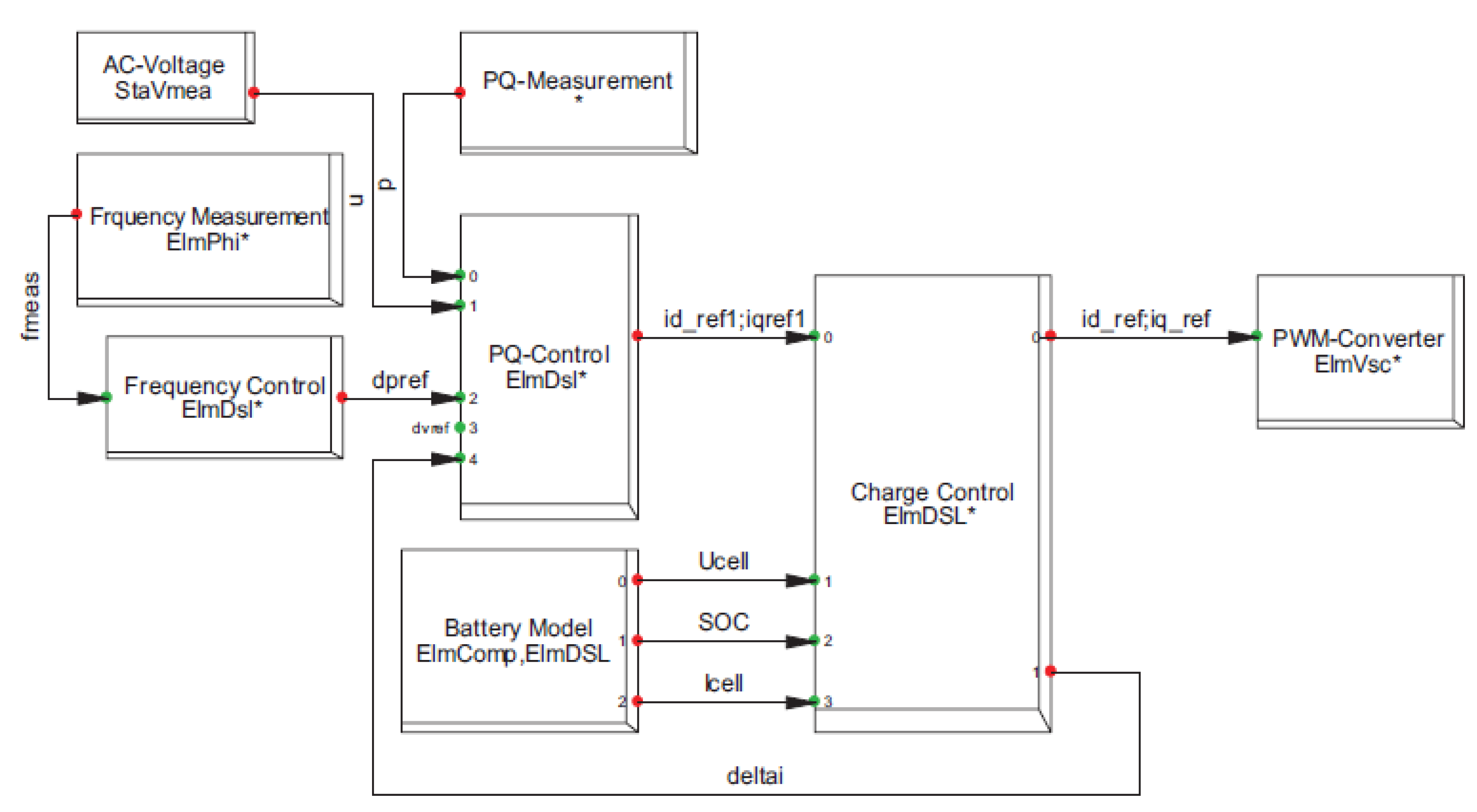
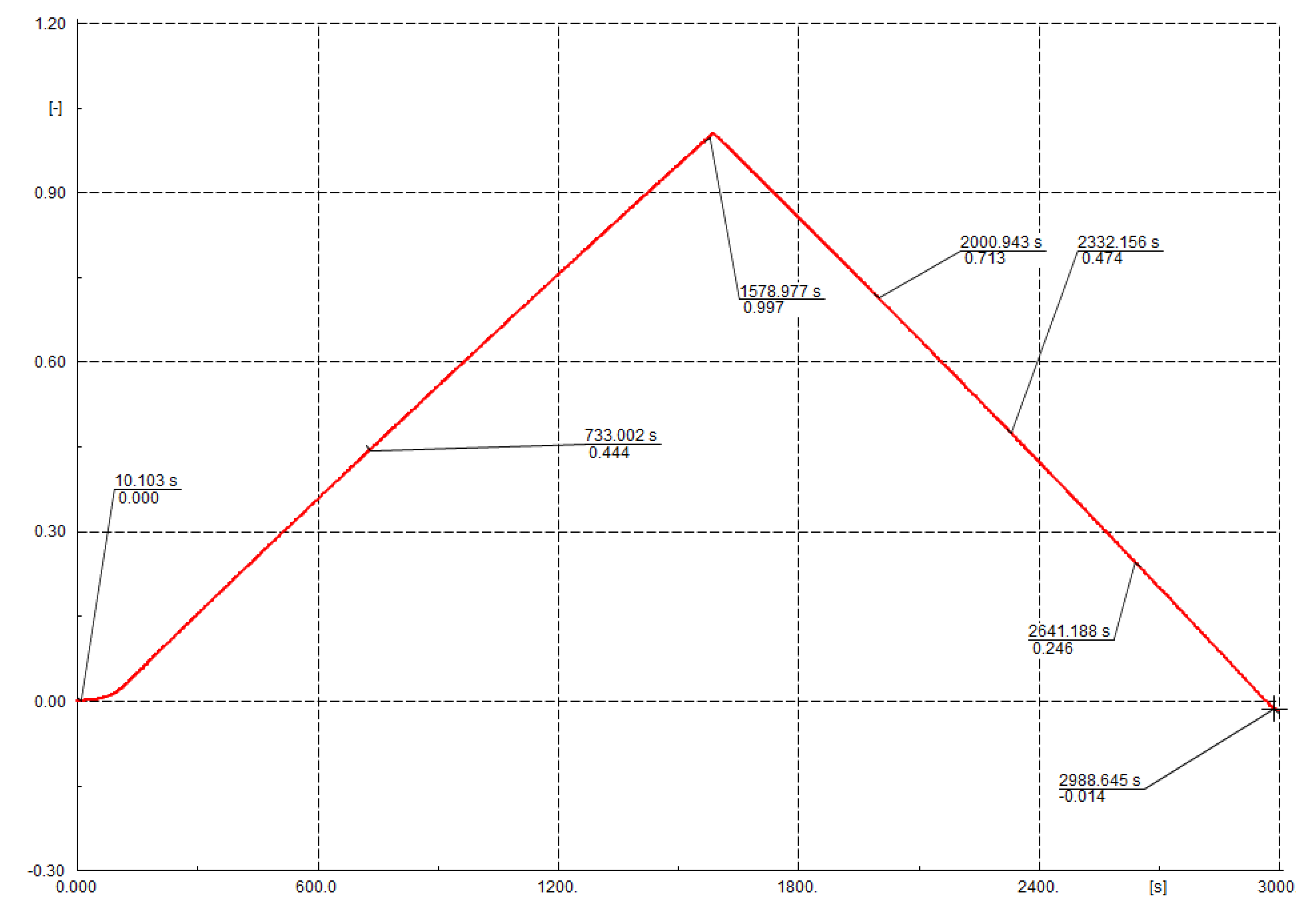
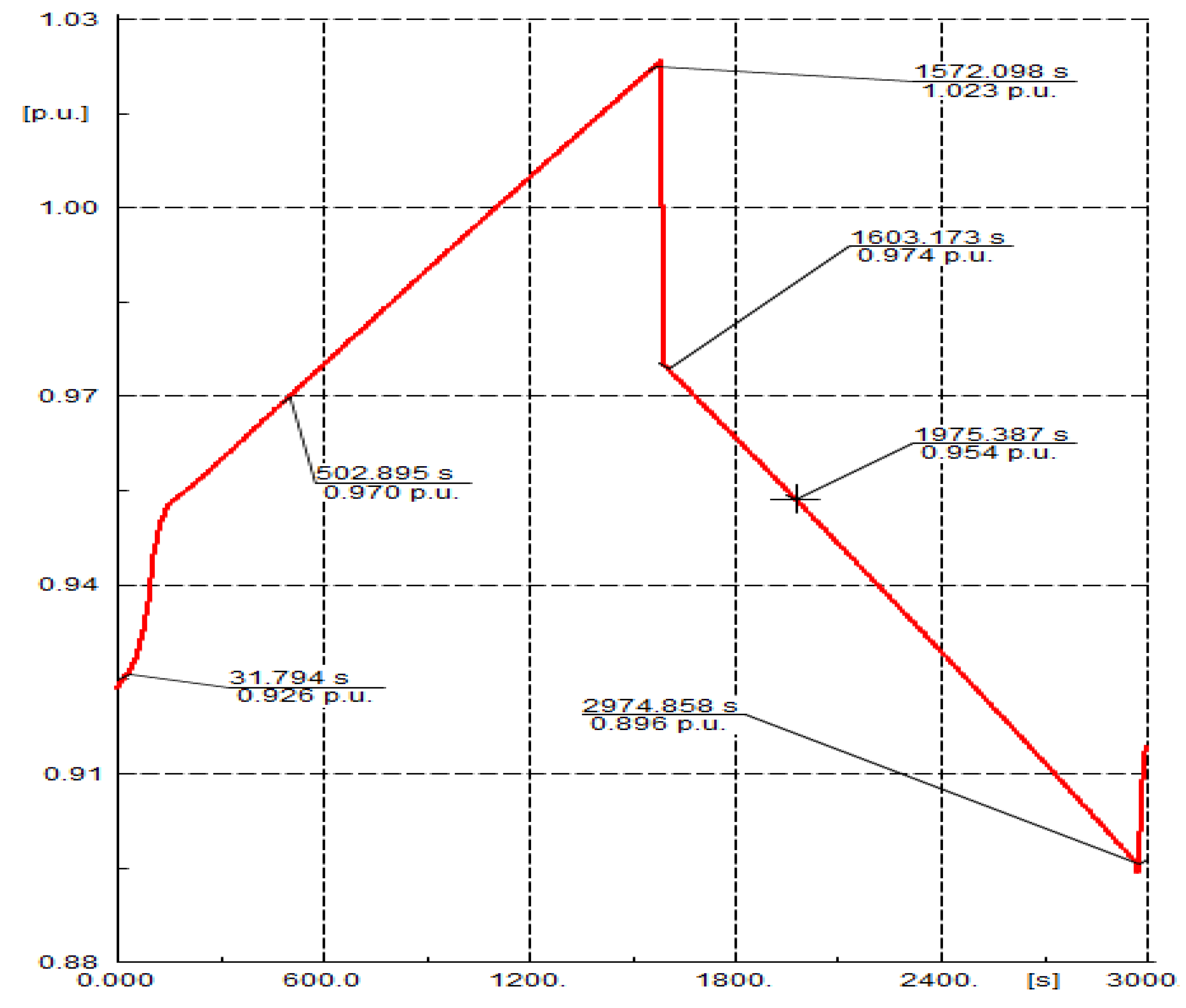
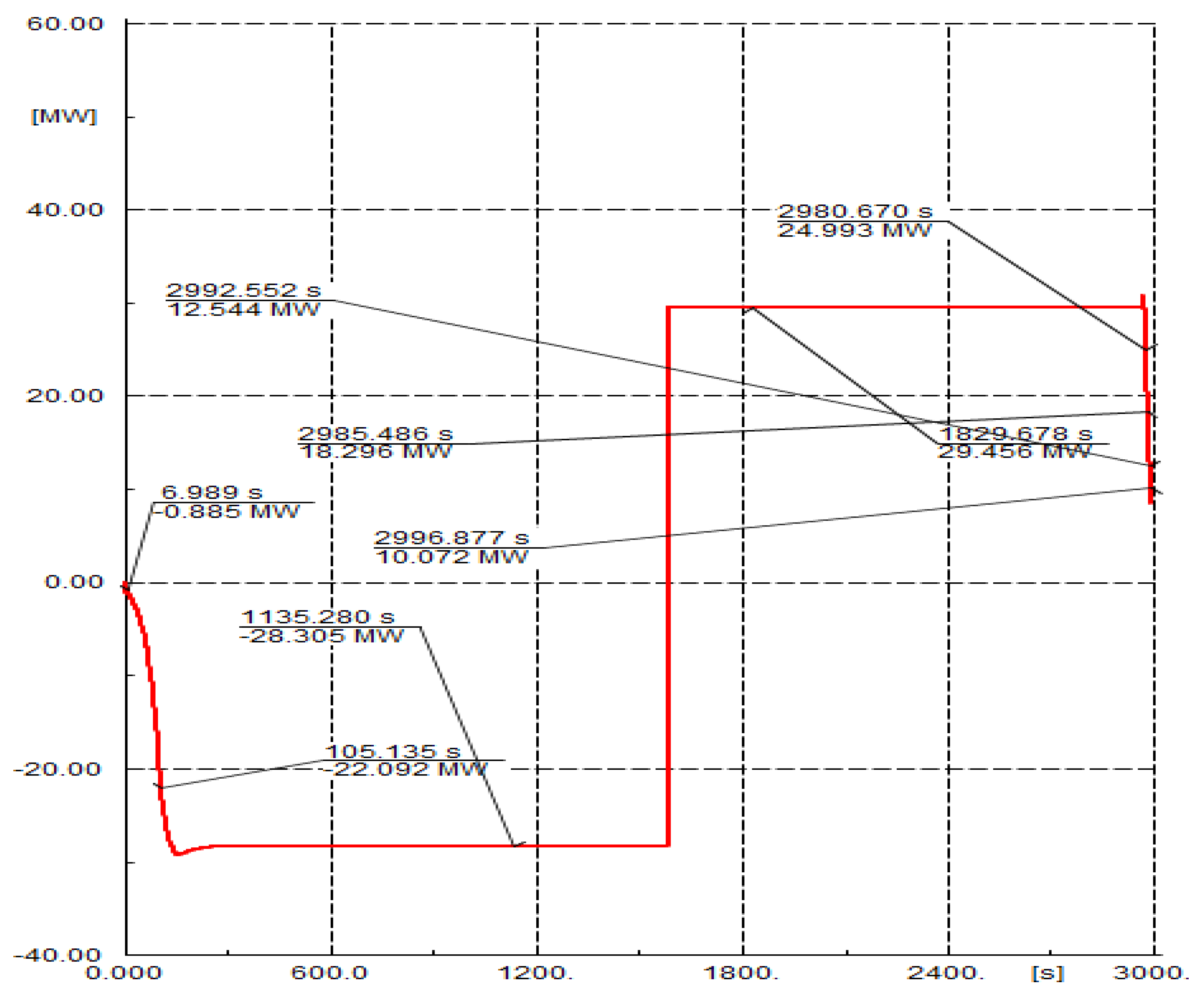
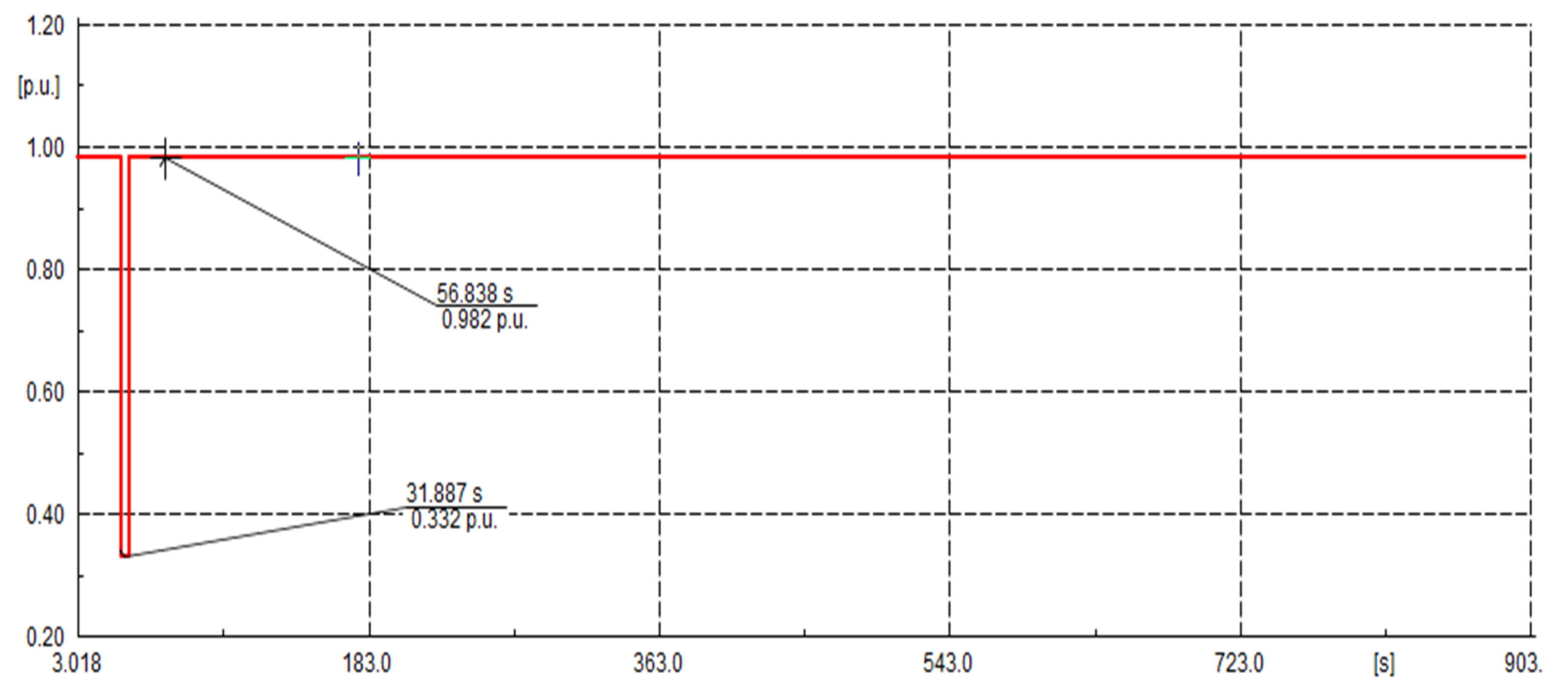


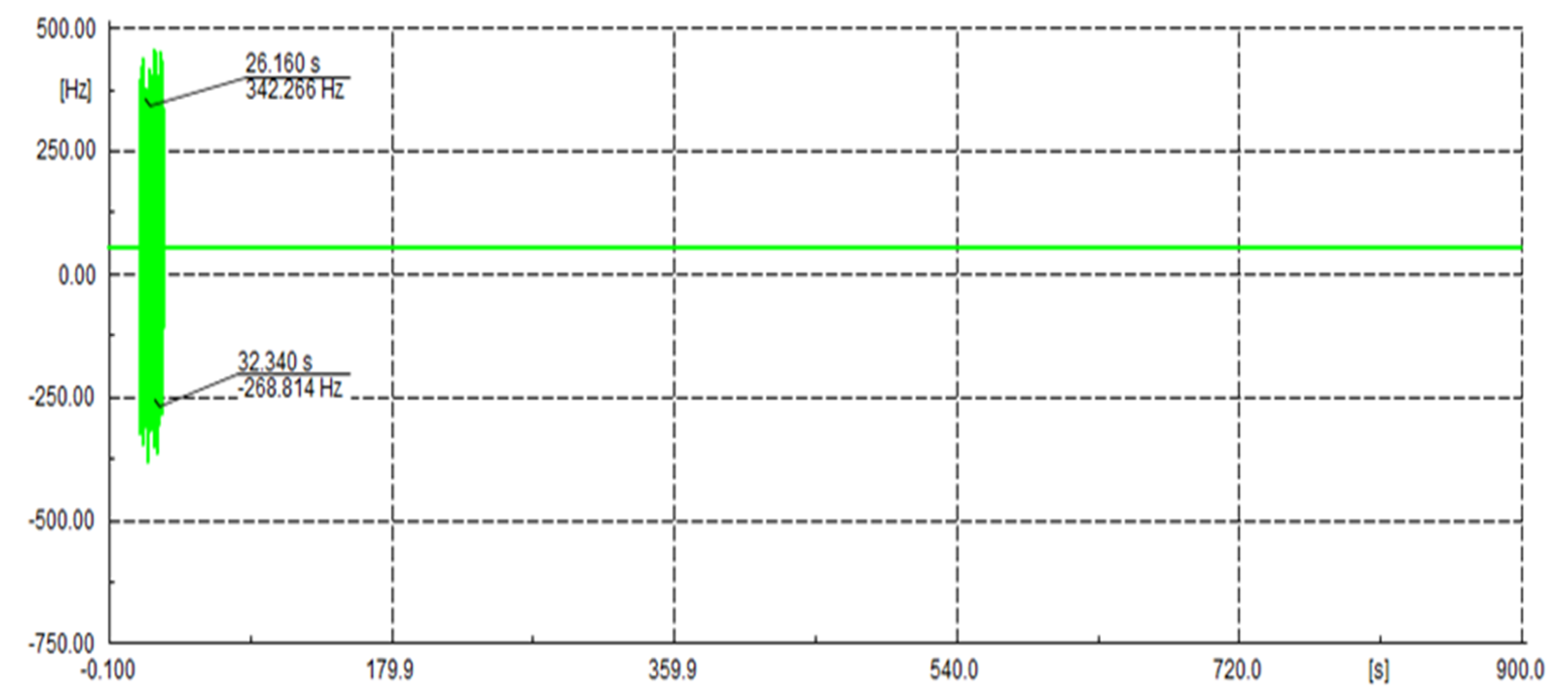










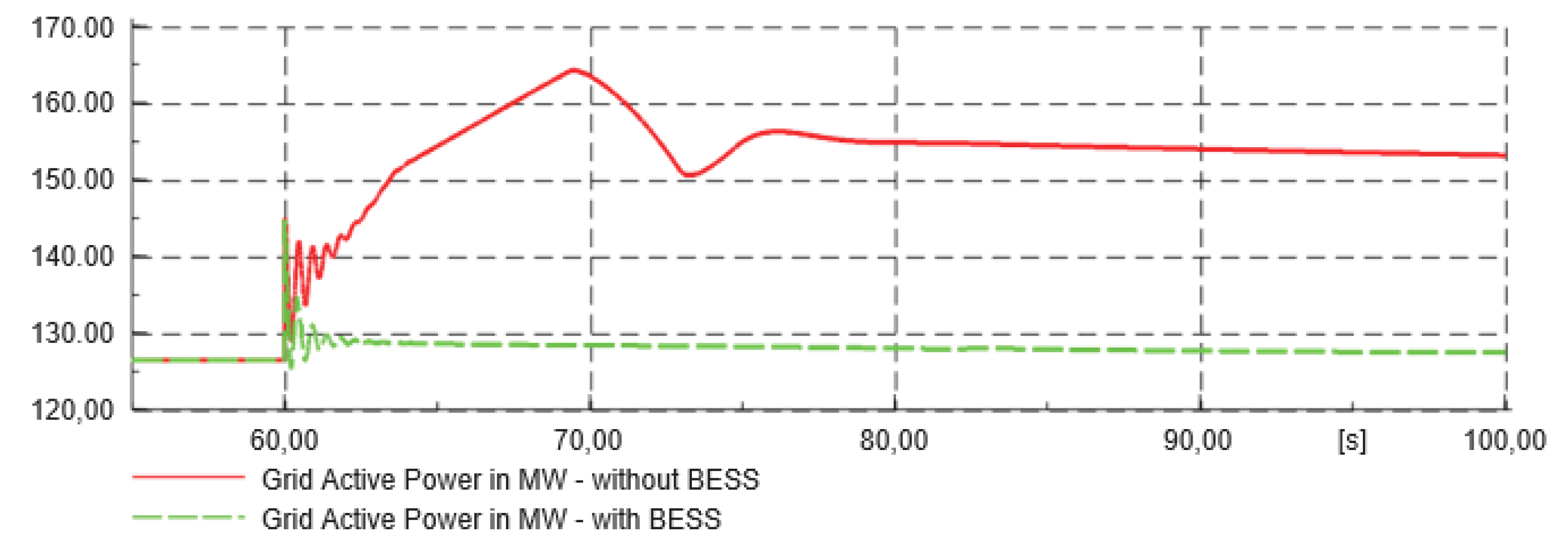
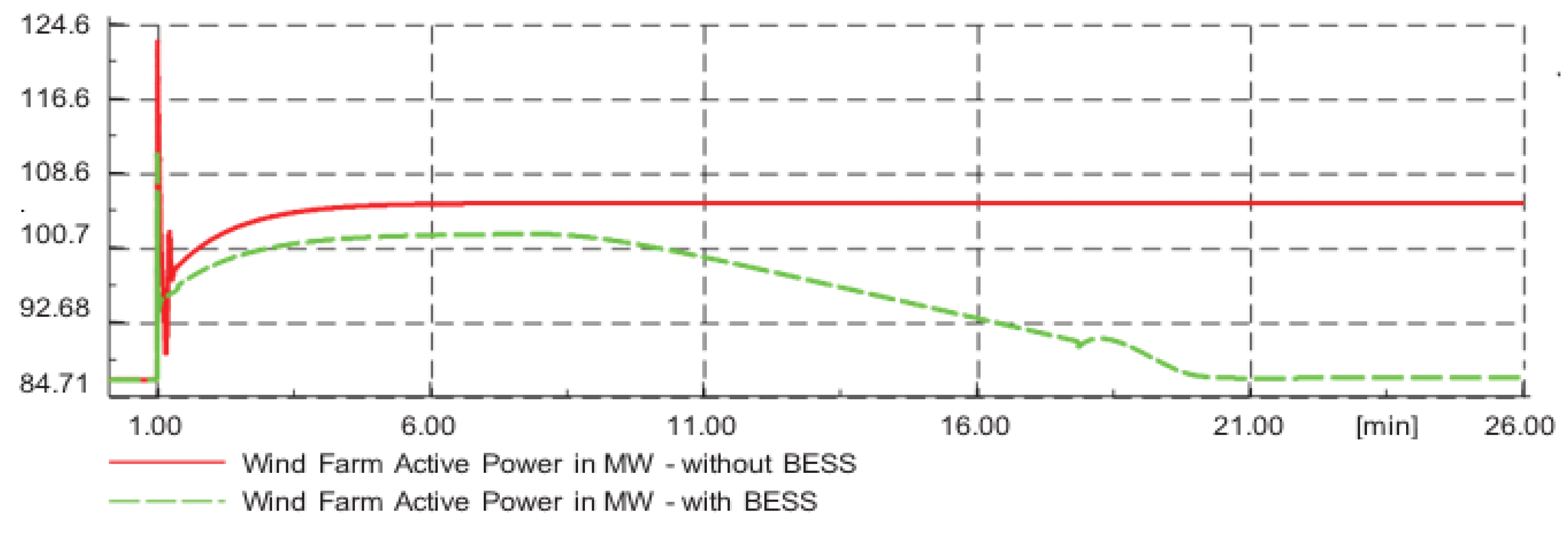
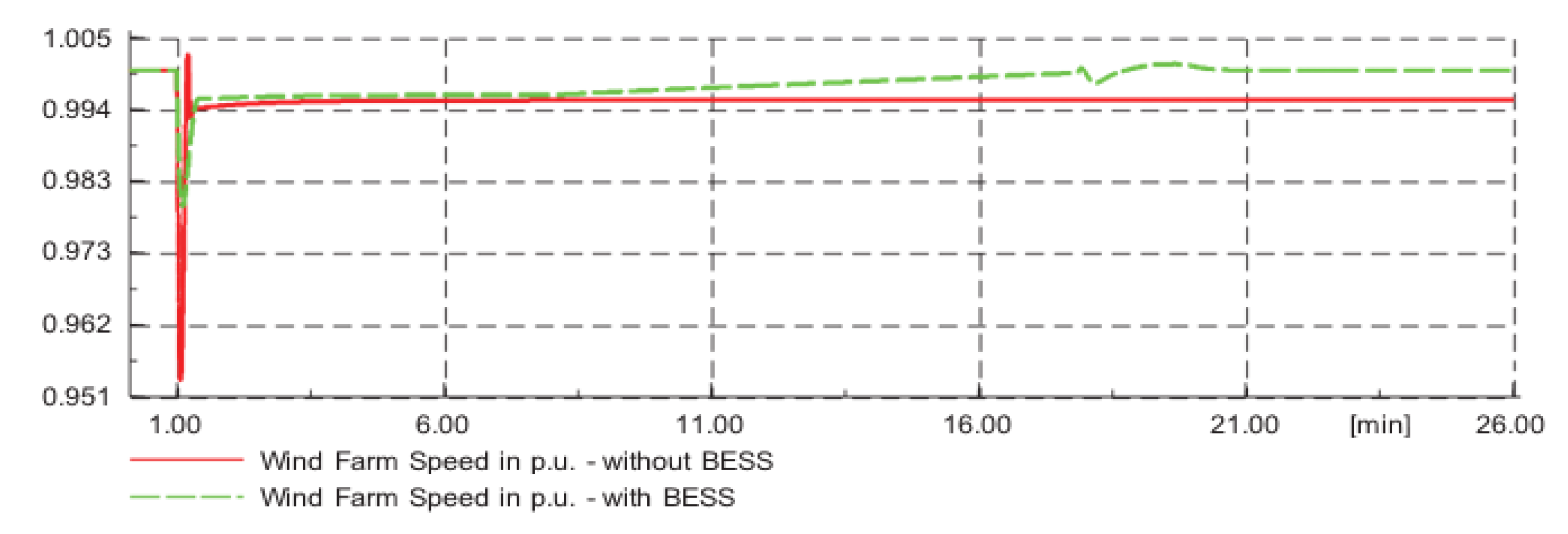

| Parameter | Description | Total Units |
|---|---|---|
| α | Battery self-discharge rate | 0.98%/day |
| β | Charging efficiency | 0.95% |
| γ | Discharging efficiency | 1.05% |
| Mc | Maximum charging threshold | −37 MW |
| Md | Maximum discharging threshold | 54 MW |
| Month | Monthly Production | Daily Average | Hourly Average | Unit | Capacity Factor |
|---|---|---|---|---|---|
| January | 26,415.7 | 852.11 | 35.5 | MWh | 25.7% |
| February | 22,835.5 | 815.6 | 34 | MWh | 24.6% |
| March | 22,766.3 | 734.4 | 30.6 | MWh | 22.2% |
| April | 20,377.6 | 679.3 | 28.3 | MWh | 20% |
| May | 16,414.7 | 529.5 | 22.1 | MWh | 16% |
| June | 19,021.3 | 634 | 26.4 | MWh | 19.1% |
| Month | Monthly Production | Daily Average | Hourly Average | Unit | Capacity Factor |
|---|---|---|---|---|---|
| January | 6603.93 | 213.03 | 8.88 | MWh | 34% |
| February | 5708.88 | 203.89 | 8.50 | MWh | 27% |
| March | 5691.58 | 183.60 | 7.65 | MWh | 30% |
| April | 5094.40 | 169.81 | 7.08 | MWh | 26% |
| May | 4103.68 | 132.38 | 5.52 | MWh | 22% |
| June | 4755.33 | 158.51 | 6.60 | MWh | 24% |
| Parameter | Description | Total Units |
|---|---|---|
| Rated Output | 1.2 MW and 8.64 MWh | 50.4 MW and 362.88 MWh |
| Configuration | 40 NAS modules, each rated at 30 kW and 216 kWh. | 40 × 4 2 = 1680 NAS Modules |
| Dimension | 10.2 W × 4.4 D × 4.8 H (m) | 42 × 10.2 W × 4.4 D × 4.8 H (m) |
| Weight | 132,000 kg | 132,000 × 42 = 5,544,000 kg |
Publisher’s Note: MDPI stays neutral with regard to jurisdictional claims in published maps and institutional affiliations. |
© 2021 by the authors. Licensee MDPI, Basel, Switzerland. This article is an open access article distributed under the terms and conditions of the Creative Commons Attribution (CC BY) license (http://creativecommons.org/licenses/by/4.0/).
Share and Cite
Gwabavu, M.; Raji, A. Dynamic Control of Integrated Wind Farm Battery Energy Storage Systems for Grid Connection. Sustainability 2021, 13, 3112. https://doi.org/10.3390/su13063112
Gwabavu M, Raji A. Dynamic Control of Integrated Wind Farm Battery Energy Storage Systems for Grid Connection. Sustainability. 2021; 13(6):3112. https://doi.org/10.3390/su13063112
Chicago/Turabian StyleGwabavu, Mandisi, and Atanda Raji. 2021. "Dynamic Control of Integrated Wind Farm Battery Energy Storage Systems for Grid Connection" Sustainability 13, no. 6: 3112. https://doi.org/10.3390/su13063112
APA StyleGwabavu, M., & Raji, A. (2021). Dynamic Control of Integrated Wind Farm Battery Energy Storage Systems for Grid Connection. Sustainability, 13(6), 3112. https://doi.org/10.3390/su13063112






